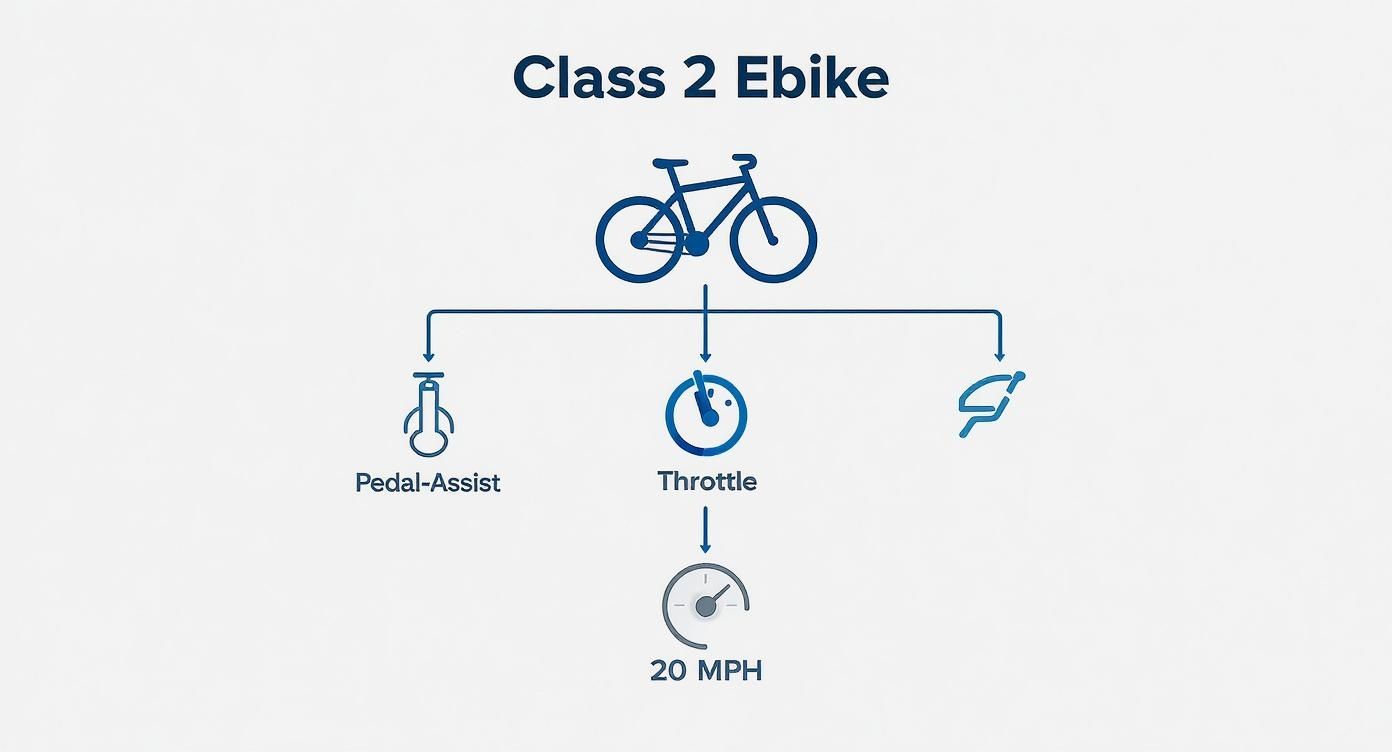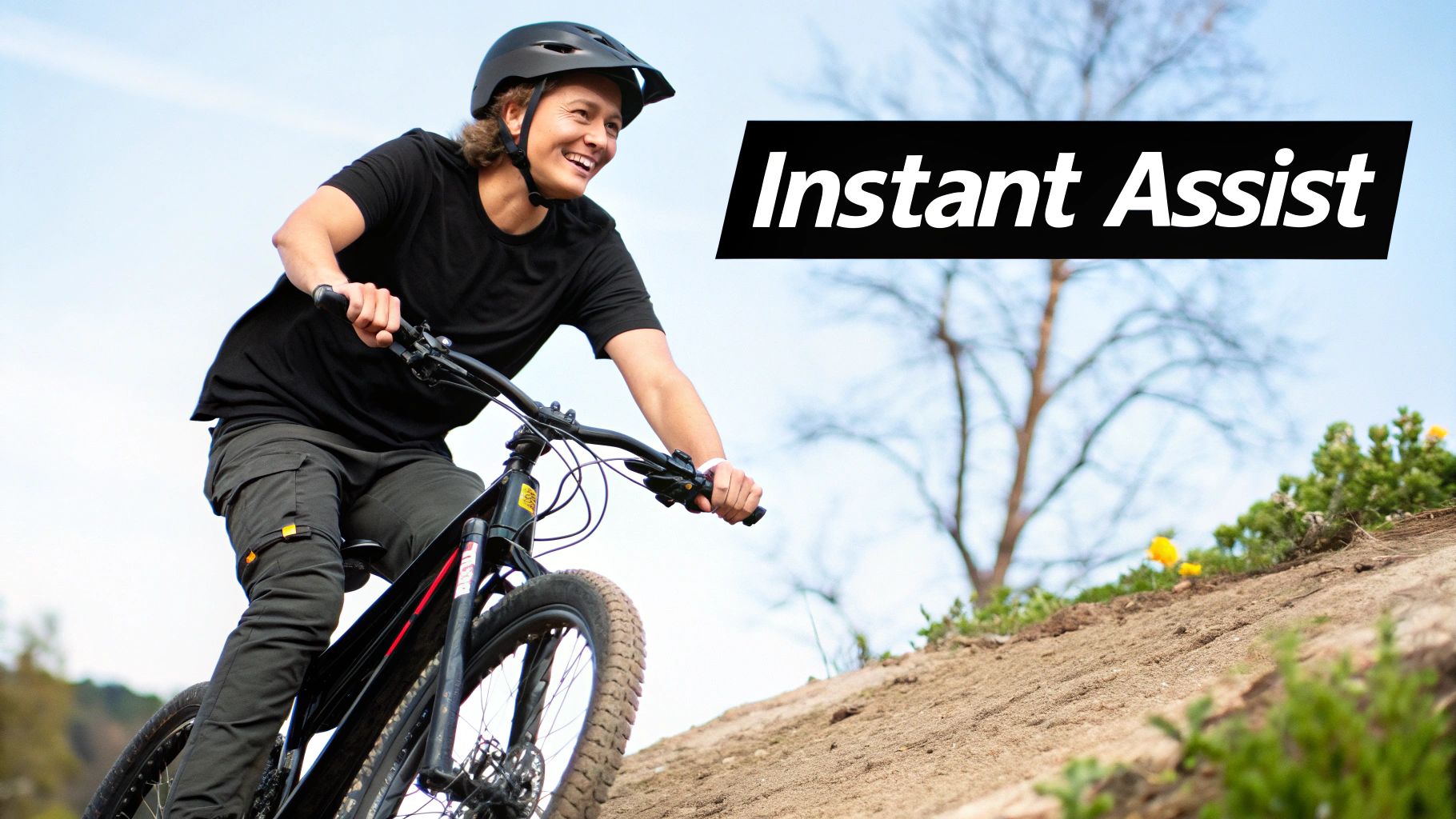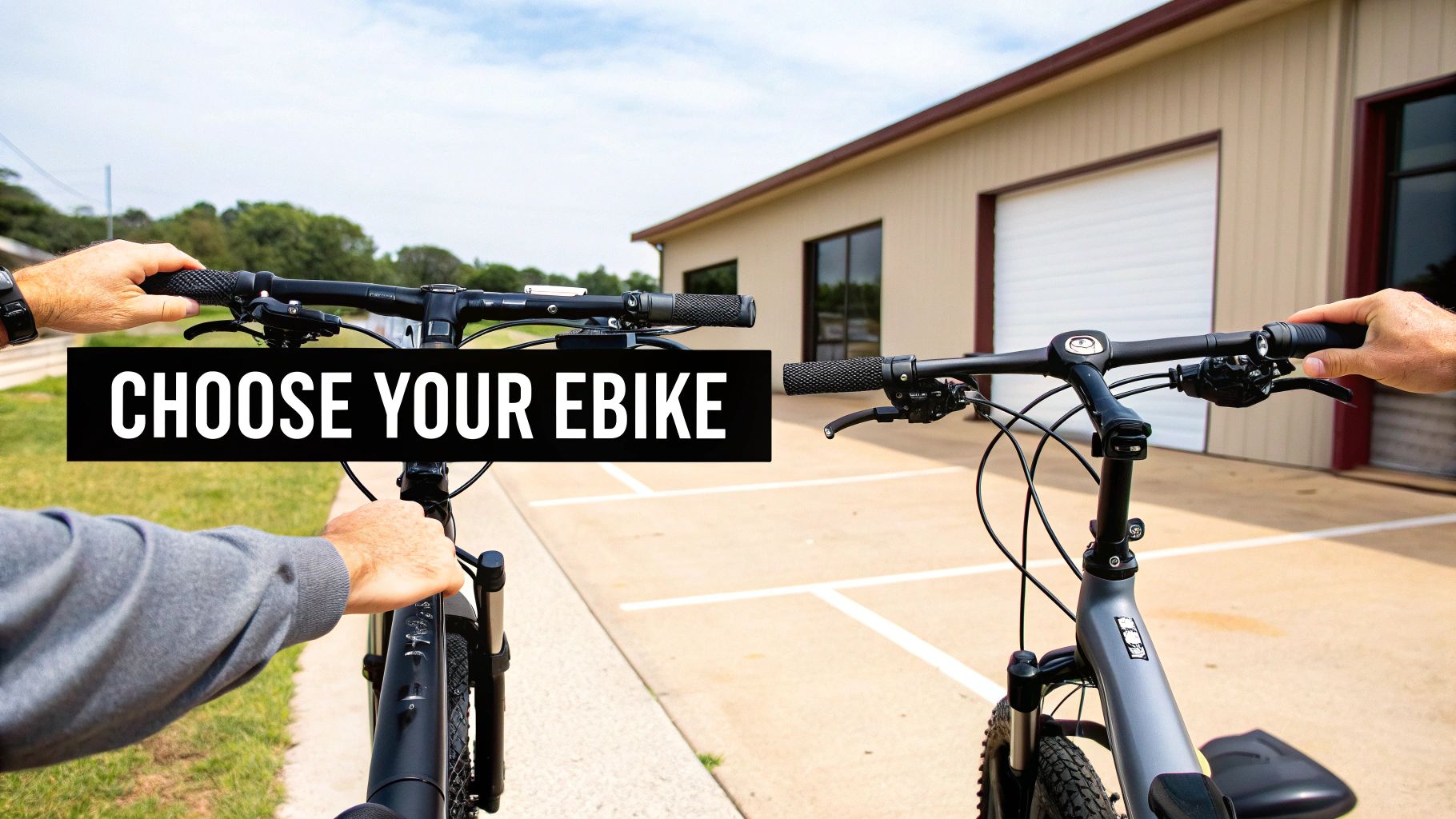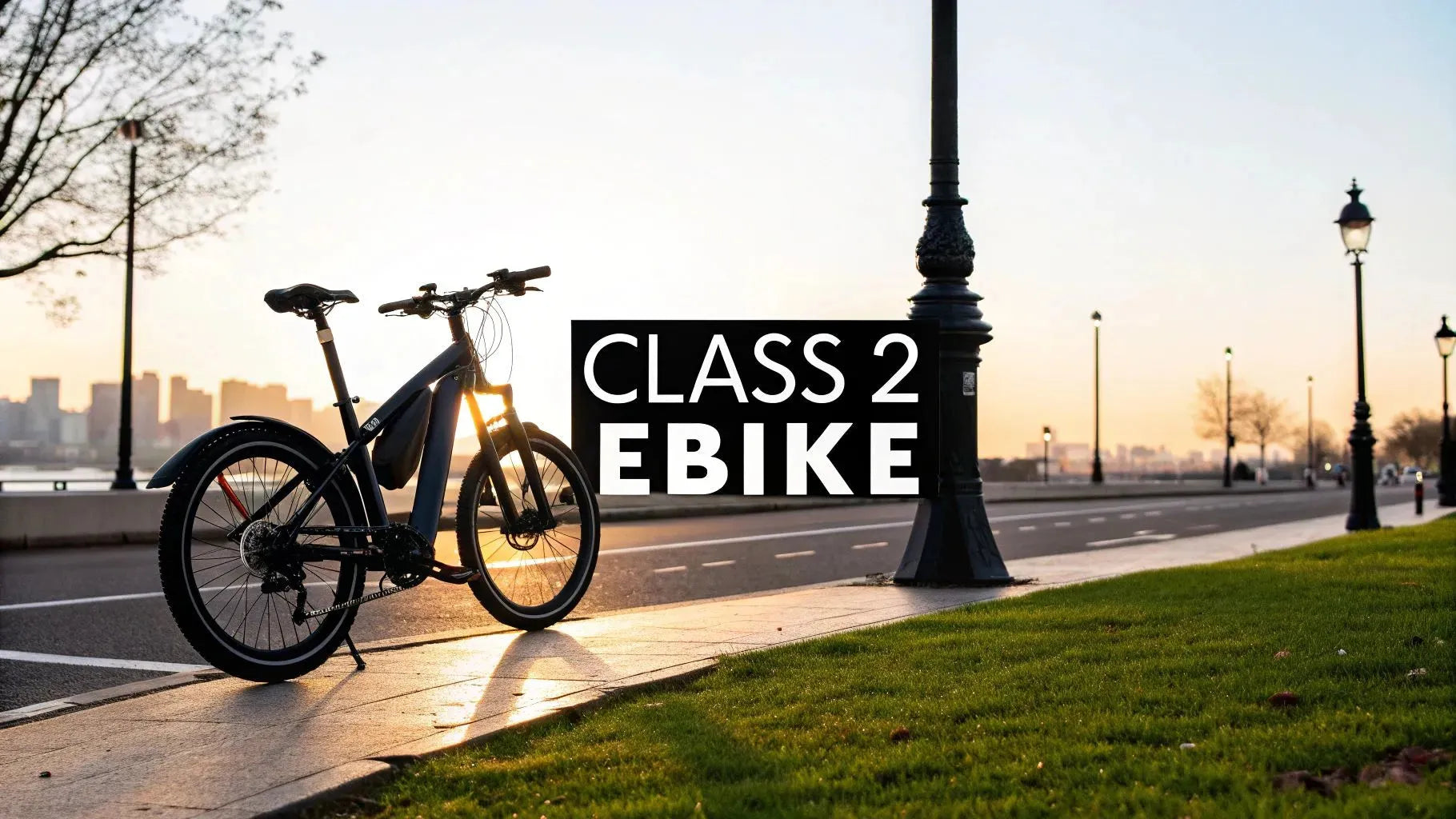So, you've heard about Class 2 e-bikes, but what exactly does that mean, especially if you're riding in the United States or Australia? Put simply, a Class 2 e-bike comes with a throttle that can power you along at up to 20 mph (or 32 km/h)—no pedaling required. It's this one feature that gives you incredible flexibility, letting you cruise like you're on a scooter or pedal for a more classic bike ride feel.
What Defines a Class 2 E-Bike
Diving into the world of electric bikes can get confusing fast. In markets like the US, you'll see "Class 1," "Class 2," and "Class 3" thrown around, and they all define what a bike can (and can't) do. A Class 2 e-bike is unique because it gives you a choice. It blends the pedal-assist you find on other e-bikes with the pure, on-demand power of a throttle.
This combination makes them incredibly versatile. You can think of it like having a car with both automatic and manual modes. Feel like taking it easy? Just use the throttle and let the bike do all the work. Want to get some exercise in? Start pedaling, and the motor will give you a helpful nudge.
The Power of the Throttle
That throttle is the real star of the show for a Class 2. It’s usually a simple twist-grip on the handlebar, kind of like a motorcycle, or a small thumb lever you can press. A gentle push or twist, and whoosh—the motor kicks in and gets you moving.
This little feature is a total game-changer for a few reasons:
- Effortless Starts: It gives you a quick, zippy start from a dead stop. This is a huge help when you're trying to get through a busy intersection ahead of traffic.
- Conquering Hills: See a steep hill coming up? The throttle gives you that extra oomph to sail to the top without feeling like you just ran a marathon.
- Taking a Break: On a long ride, sometimes your legs just need a rest. With a throttle, you can sit back, cruise for a bit, and just enjoy the scenery.
A Class 2 e-bike really does give you the best of both worlds. You get the fun and fitness of a pedal-assist bike, but with the awesome convenience of a throttle when you need it.
To make it even clearer, here’s a quick summary of what makes a Class 2 e-bike what it is, especially in the US where this classification system is widely adopted.
Class 2 E-Bike at a Glance
| Feature | Specification |
|---|---|
| Motor Assistance | Pedal-Assist & Throttle |
| Maximum Assisted Speed | 20 mph (32 km/h) |
| License Required | No (in most US states) |
| Primary Use Case | Urban commuting, recreational riding |
This table sums it up nicely. You get two ways to ride, a top speed of 20 mph with motor help, and you can ride it just about anywhere you'd ride a regular bike.
How E-Bike Classes Compare in the Real World
Knowing the technical details of a Class 2 e-bike is a great start, but the real "aha!" moment comes when you see how it stacks up against its siblings—Class 1 and Class 3. This three-class system is the standard in the United States, creating clear guidelines for riders. Think of it like this: the e-bike family has three distinct personalities, and each one is a perfect fit for a different kind of rider and a different kind of journey.
This visual really captures the essence of a Class 2: it’s the only one that gives you both pedal-assist and a throttle, all while topping out at 20 MPH.

It’s this unique blend of power on demand that makes the Class 2 such a flexible and popular choice for so many different types of rides.
Class 1: The Purist's Pedal-Assist
If you love the feeling of riding a traditional bike but just want a helpful nudge up the hills, the Class 1 is for you. Its motor only kicks in when you’re actively pedaling, giving you a boost up to 20 MPH. No throttle here—you’re always in the driver’s seat, just with a bit of a tailwind.
These bikes are fantastic for riders who want to keep the exercise but make tough routes a little more manageable. Because they don’t have a throttle, they’re usually welcome on the widest variety of bike paths and trails where other e-bikes might not be. If you want to learn more, you can get the full rundown in our guide on what is a Class 1 ebike.
Class 3: The High-Speed Commuter
At the other end of the spectrum, you have the Class 3 e-bike—a machine built for speed and getting things done. Like a Class 1, it uses pedal-assist, but it’ll keep pushing you all the way up to a brisk 28 MPH. That extra kick makes it a dream for commuters who need to keep up with traffic on their way to work.
But with great speed comes greater responsibility (and restrictions). You'll typically find Class 3 e-bikes are confined to streets and dedicated bike lanes. They’re rarely allowed on shared-use paths, so keep that in mind. Think of them as the performance vehicles of the e-bike world, built for riders focused on getting from A to B as quickly as possible.
Class 2: The Ultimate All-Rounder
And that brings us back to the star of the show: the Class 2 e-bike. It sits perfectly in the middle, offering a little bit of everything. Just like a Class 1, its pedal-assist tops out at 20 MPH. But the game-changer is the throttle, which lets you cruise along without pedaling at all.
This dual-power system makes it the ultimate choice for riders who crave options. Feel like a workout? Pedal away. Need a quick start at a stoplight or a break for your legs on the ride home? Just twist the throttle. This incredible versatility is a huge reason why the global e-bike market, valued at $54.12 billion USD in 2025, is expected to soar to $87.15 billion USD by 2032. Class 2s are a major driver of that growth in markets like the US and Australia.
In short, a Class 2 e-bike gives you the freedom of a scooter with all the benefits of a bicycle. It’s a true jack-of-all-trades, just as comfortable on a lazy weekend cruise as it is on a hectic daily commute.
To make it even clearer, let's break down the key differences side-by-side.
E-bike Class Comparison Chart
This table lays out the core specs for each class, so you can see at a glance what makes each one unique.
| Feature | Class 1 E-bike | Class 2 E-bike | Class 3 E-bike |
|---|---|---|---|
| Top Assisted Speed | 20 MPH | 20 MPH | 28 MPH |
| Motor Activation | Pedal-Assist Only (Pedelec) | Pedal-Assist and Throttle | Pedal-Assist Only (Pedelec) |
| Throttle? | No | Yes | No |
| Primary Use Case | Recreation, Fitness, Trail Riding | Commuting, Errands, All-Purpose | High-Speed Commuting, Long-Distance |
| Trail Access | Widest access, often allowed where others aren't | Generally good, but some restrictions apply | Most restricted, often limited to roads and bike lanes |
Ultimately, the Class 2 hits that sweet spot of functionality and accessibility, making it an easy choice for riders who want an e-bike that can truly do it all.
Why Riders Love the Class 2 Throttle
Looking at specs and class comparisons is one thing, but it doesn't really get to the heart of what makes riding a Class 2 e-bike so great. The real magic boils down to a single feature: the throttle. It’s not just some button or twist-grip; it’s like having a superpower on demand, completely changing how you ride.

Picture this: you're stopped at a busy intersection, cars buzzing all around you. The light flips green. Instead of that wobbly, slow start we all know, you just give the throttle a little nudge. Instantly, you're zipping ahead, clear of the cars and safely through the junction before anyone behind you has even shifted into first gear. It's not just a convenience—it's a huge safety boost in stop-and-go city traffic.
The Commuter's Best Friend
Let me give you a real-world example. I have a friend, Alex, a graphic designer in Sydney who used to hate his commute across the Harbour Bridge. The worst part was a monster of a hill right before his office that left him sweaty and out of breath before he even sat down at his desk.
Then he got a Class 2 e-bike, and everything changed. That hill he used to dread? It's now the best part of his ride. He still pedals most of the way, but when he hits that incline, a simple twist of the throttle sends him gliding right to the top. He shows up to work feeling energized and focused, not like he just ran a marathon. His commute went from a chore to a highlight of his day.
The throttle on a Class 2 e-bike is the ultimate equalizer. It flattens hills, erases fatigue, and takes the stress out of traffic, opening up the joy of cycling to so many more people.
That power-on-demand is what people fall in love with. It gives you a sense of freedom and control that you just don't find on a bike that only has pedal assist. It's the perfect mix of getting some exercise and taking it easy when you need to.
More Than Just a Commute
But the throttle isn't just for getting to work. It makes pretty much every ride better, whether you’re just grabbing groceries or out exploring new bike paths on a weekend.
- Hauling Heavy Stuff: Got a backpack loaded with groceries or a heavy laptop bag? The throttle gets you moving from a dead stop without that initial lurch or strain on your knees.
- Giving Your Legs a Rest: We've all been there on a long ride—your legs just feel like jelly. The throttle lets you cruise for a bit, catch your breath, and just enjoy the scenery without having to stop completely.
- Keeping Up with the Pack: Riding with a friend who's a bit faster? The throttle is your secret weapon to keep pace, making group rides more about the fun and less about the struggle.
At the end of the day, the throttle is all about having options. It gives you the confidence to handle whatever the ride throws at you, making sure you’re always in control. It's this flexibility that makes so many riders feel a Class 2 e-bike isn't just a bike, but a genuine upgrade to their entire lifestyle.
Navigating E-Bike Laws: What to Know in the US and Australia
Knowing the rules of the road is the first step to enjoying your e-bike safely and legally. And when it comes to e-bikes, where you ride matters—a lot. What’s considered a standard Class 2 e-bike in the United States could be classified differently in Australia, though both countries generally offer more freedom for throttle-equipped bikes than the UK or EU.
In the US, things are relatively straightforward. Most states (over 30 and counting!) have adopted the three-class system, which gives riders and lawmakers a common language. A Class 2 e-bike, with its handy throttle and motor that cuts out at 20 mph, is typically treated just like a regular bicycle. You can usually ride it wherever you’d ride a normal bike, no license or registration required.
The US Approach: Freedom with a Throttle
The American system is pretty welcoming to e-bikes, seeing them as a great way to get people out of cars. Because a Class 2 e-bike’s motor assistance tops out at a manageable 20 mph, it’s generally seen as safe enough for shared bike paths and trails where you’ll be mixing with pedestrians and traditional cyclists.
But "generally" is the word to remember. While state laws create a solid foundation, local cities, parks, and trail systems can—and often do—set their own rules. It’s always a good idea to do a quick search on local regulations before you head out to explore a new trail. For a closer look at the rules where you live, check out our guide to electric bike laws by state.
A Different Story in Australia
Hop across the Pacific, and the conversation changes, but the spirit is similar. Australia doesn't use the "Class 1, 2, 3" system. Instead, the rules focus on motor power and whether the bike is a "pedalec." To be legally considered a bicycle, an e-bike must have a motor of 250 watts or less, and it can only provide assistance when you are pedaling.
However, many bikes sold in Australia that function like a US Class 2 (with a throttle that works independently) are still legal to ride, provided they meet certain conditions. These throttle-controlled bikes are often limited to a top motor speed of 25 km/h (about 15.5 mph). If a bike exceeds these power or speed limits, it's considered a motor vehicle and requires registration and a license.
In Australia, the key is the power output and speed limit. A throttle-equipped e-bike with a 250W motor that cuts out at 25 km/h is generally fine. Anything more powerful or faster likely falls into the category of an unregistered motorbike, which can lead to serious fines.
This is a massive distinction for anyone considering an e-bike down under. Unlike the strict UK/EU rules that effectively ban throttles, Australia's regulations provide a pathway for throttle-assisted bikes, making them a popular and legal choice for many riders, as long as they adhere to the power and speed caps.
Choosing the Right Class 2 Ebike for You

Alright, so you're sold on the idea of a throttle and ready to find your perfect Class 2 ebike. It’s easy to get bogged down in technical specs, but let's be honest—it really just comes down to how you’re going to ride it. If you focus on a few key things, you can cut through the noise and find a bike that feels like it was built just for you.
Think about it like this: you wouldn't pick a tiny sports car to go on a camping trip. The same idea applies here. The right ebike should slide right into your daily routine, whether that’s zipping to the office, grabbing groceries, or just cruising around town for fun.
Matching the Bike to Your Ride
First things first, what does your typical journey look like? Think about how far you go and what kind of ground you cover. Answering this will point you directly to the features that actually matter for you.
- Battery Range: This is your fuel tank. Got a long commute? You’ll want a bigger battery, measured in watt-hours (Wh), so you're not sweating about making it home. But if your daily trip is just a couple of miles, you can easily get by with a smaller, lighter battery.
- Motor Power: A bike's motor is measured in watts (W). For mostly flat city streets, a 250W or 500W motor is more than enough to get you going. But if you live somewhere with serious hills, a punchier 750W motor will give you that extra torque to climb them without having to stand up on the pedals.
- Frame Style: Comfort is everything. A classic diamond frame is strong and timeless, but a step-through frame is a game-changer for getting on and off easily. This is a huge bonus if you’re making lots of stops or riding in regular clothes instead of cycling gear.
Picking the right bike is all about being honest with yourself. Get real about what you truly need, and you’ll end up with a Class 2 ebike that makes every ride feel like a breeze. For a deeper dive, check out our complete guide on how to choose an ebike.
Don't Overlook the Details
Beyond the big three, there are a bunch of smaller features that can make a massive difference in your day-to-day experience. These are the little things that take a bike from "good" to "I can't live without it."
I'm talking about things like integrated lights for those early morning or late-night rides, or built-in racks that make carrying your work bag and groceries a non-issue. Even the tires matter—thicker, puncture-resistant ones are a lifesaver on city streets littered with glass and debris.
It's these practical perks that are fueling the ebike boom. The global market for these bikes was valued at around $2.5 billion USD in 2025 and is expected to skyrocket to $7.8 billion USD by 2033. That kind of growth tells you just how many people are realizing how a well-chosen Class 2 ebike can change the game. You can dig into the numbers and trends in the full research on the Class 2 e-bike market.
Got Questions About Class 2 Ebikes? We've Got Answers.
Okay, so we've covered the basics of what makes a Class 2 ebike tick. But I know from experience that once you start seriously considering one, a whole new set of practical questions bubble up. Let's get right into them and clear up any lingering confusion.
Think of this as the final check-in before you commit. We'll tackle the real-world stuff—where you can ride, what paperwork you need (or don't), and how to keep your new ride in great shape.
Can I Take a Class 2 Ebike on Bike Paths and Trails?
This is probably the number one question I get, and the honest answer is: it really depends on where you live.
Here in the US, where the class system is standard, Class 2 ebikes are often welcome on the same paths and multi-use trails as regular bikes. But—and this is a big but—local rules always trump the general guidelines. A city park, a state forest, or a specific trail network can absolutely set its own, stricter rules.
In Australia, the rules can be more uniform. Generally, a legal e-bike (250W, 25 km/h assist limit) can be ridden on bike paths and shared paths where bicycles are allowed. However, just like in the US, local councils or national parks can impose their own restrictions, especially on sensitive trails like single-track mountain bike paths.
The golden rule? Always check local rules before you ride. A quick search on your city's council or parks website can save you a headache and a potential fine. It’s all about riding where you’re welcome.
Do I Need a License or Insurance?
In the United States, you can breathe a sigh of relief. For a Class 2 ebike, the answer is almost always a simple "no." They're treated just like a standard bicycle, so you don't need a driver's license, registration, or special insurance. That simplicity is a huge part of their appeal.
It's a similar story in Australia. As long as your e-bike meets the legal definition of a "pedalec" or throttle-assisted bike (under 250W and limited to 25 km/h), you don't need a license or registration. It's treated like a bicycle. The moment you have a bike that's more powerful or faster, it's legally a motorbike, and all those requirements kick in.
How Far Can I Actually Go on One Charge?
The range on a Class 2 ebike can be all over the map, but you can generally expect somewhere between 20 to 50 miles (32 to 80 km) on a full battery. This number, however, is massively influenced by how you ride.
- Throttle Happy? Relying purely on the throttle will chew through your battery way faster than using pedal-assist. It's like flooring the gas pedal in your car versus gentle cruising.
- Weight Matters: The more weight the bike has to carry (you plus any gear), the harder the motor has to work, and the more juice it uses.
- Hills Are a Killer: Climbing steep hills is the ultimate battery drainer. Cruising on flat ground is far more efficient.
- Battery Size: A battery with a bigger watt-hour (Wh) rating is like having a larger gas tank. Simple as that.
My advice? Treat the manufacturer's range estimate as a "best-case scenario" and plan your longer trips with a bit of a buffer.
Is It a Hassle to Maintain a Class 2 Ebike?
Not at all. Here's the good news: about 90% of what you need to do is identical to taking care of a regular bike. You’ll still need to keep your tires inflated, your chain clean and lubed, and your brakes dialed in.
The only new parts are the electrical bits—the motor, battery, and controller. These are almost always sealed units that don't need any tinkering. Your main job is just taking care of the battery. Try to keep it out of extreme heat or cold and aim to keep the charge between 20% and 80% to make it last as long as possible. Getting an annual tune-up from a good ebike mechanic is also a smart move to keep everything humming along.
Ready to find the Class 2 ebike that fits your life perfectly? At Punk Ride LLC, we’ve hand-picked a selection of top-tier electric bikes from the best brands out there. Explore our collection and kick off your next adventure today at https://www.punkride.com.





Share:
Electric Scooter vs Electric Bicycle: A US & Australian Guide
best helmet for electric scooter: Top Safety Picks